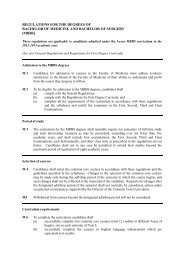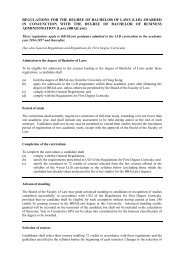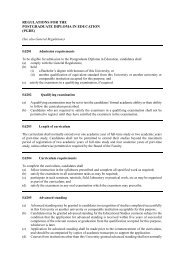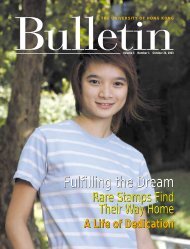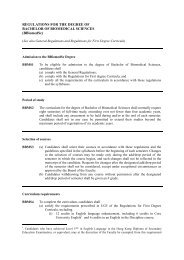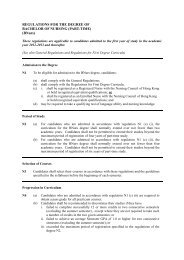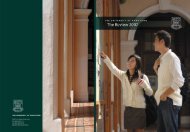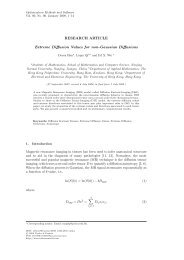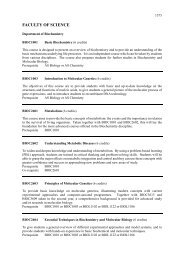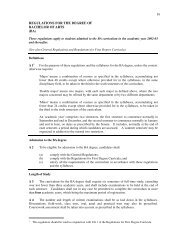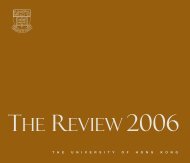Bachelor of Arts (BA) - The University of Hong Kong
Bachelor of Arts (BA) - The University of Hong Kong
Bachelor of Arts (BA) - The University of Hong Kong
Create successful ePaper yourself
Turn your PDF publications into a flip-book with our unique Google optimized e-Paper software.
126CLIT2065.<strong>Hong</strong> <strong>Kong</strong> culture: Representations <strong>of</strong> identity in literature and film (6 credits)(This course is also <strong>of</strong>fered to second and third year non-<strong>BA</strong> students for inter-Faculty broadeningpurposes.)This course traces the formation <strong>of</strong> identities in <strong>Hong</strong> <strong>Kong</strong> history and analyzes different perspectivesin understanding these identities. It focuses on various forms <strong>of</strong> colonization and their influences on theconstruction <strong>of</strong> cultural artifacts and relationships. Various theoretical approaches and debates onpostcolonialism, capitalism, and urban culture will be adopted to examine selected texts <strong>of</strong> literatureand film.CLIT2066.Postmodernism (6 credits)(This course is also <strong>of</strong>fered to second and third year non-<strong>BA</strong> students for inter-Faculty broadeningpurposes.)We are constantly bombarded with images by the media day and night. MTV is equally popular in thedeveloped as well as in the developing countries. <strong>The</strong> old distinction between high culture and popularculture is breaking down. Literature and film genres are being constantly mixed, resulting in compositeand hybrid works. More and more <strong>Hong</strong> <strong>Kong</strong> Chinese live in Toronto, Melbourne, London and SanFrancisco while more and more Filipinos come to <strong>Hong</strong> <strong>Kong</strong> as housemaids. <strong>The</strong> postmodern world isfull <strong>of</strong> fascinating phenomena. In this course we plan to study postmodernism by focusing on literature,cinema, art, and other cultural productions. <strong>The</strong> aim <strong>of</strong> the course is not to define postmodernism butrather to evoke and question it as we seek to make sense <strong>of</strong> the radical changes taking place in ideas andexperiences related to technology, entertainment, art, everyday life and the problems <strong>of</strong> representation.CLIT2067.Re-placing Shakespeare (6 credits)This course 'replaces' Shakespeare not by removing his work from the agenda, but by reconsidering hisplace in contemporary criticism and popular cultural practice. Some <strong>of</strong> the topics the course may dealwith are: feminist, psychoanalytic and literary historicist re-readings <strong>of</strong> Shakespeare's texts;comparisons <strong>of</strong> how international film directors, with their differing multi-cultural perceptives, havehandled the problems <strong>of</strong> filming Shakespeare; and the way that Shakespeare has been adapted andre-imagined by innovative and influential modern artists.CLIT2068.Gender dialogue in Maxine <strong>Hong</strong> Kingston: An intertextual study <strong>of</strong> <strong>The</strong> WomanWarrior and China Men (6 credits)Maxine <strong>Hong</strong> Kingston herself admitted that <strong>The</strong> Woman Warrior and China Men were first conceivedas one big saga. In the end, however, she created two distinct narratives <strong>of</strong> the Chinese women and menwho made <strong>Hong</strong> Family history. Her stated rationale for this was that “my men’s stories wereweakening the feminist point <strong>of</strong> view. So I took all the men’s stories out, and then I had <strong>The</strong> WomanWarrior. Yet this reinforcement <strong>of</strong> “the feminist point <strong>of</strong> view” created gender imbalance in her texts. Itfocused critical attention on <strong>The</strong> Woman Warrior, and allowed women readers, in particular, to ignorethe fact that China Men was written as a sequel to <strong>The</strong> Woman Warrior or as volume two <strong>of</strong> her familysaga. It has provoked a literary battle <strong>of</strong> the sexes and led some Chinese American male critics toconclude that <strong>Hong</strong> Kingston’s writing emasculates China Men either by cutting them out <strong>of</strong> thewomen’s stories or by representing them as effeminate and powerless in their own narratives. Thiscourse aims to subvert this gender polarity by reading <strong>The</strong> Woman Warrior and China Men back intomore integral relationship to one another. It will consider theories <strong>of</strong> intertextuality that suggest adynamic interplay between the two books ad that open up the possibility <strong>of</strong> gender dialogue and a moreinclusive exchange <strong>of</strong> views. It will look at intertexts from high and popular culture that can helpreaders to understand the overall significance <strong>of</strong> the two books and that represent men and women asco-producers <strong>of</strong> meaning. <strong>The</strong>se may include (in whole or part) Nathaniel Hawthorne’s <strong>The</strong> ScarletLetter, Virginia Woolf’s Orlando, William Carlos Williams’s In the American Grain, Lucille Ball’s “ILove Lucy” show, and the films Crouching Tigers and Hidden Dragons and <strong>The</strong> Matrix.



